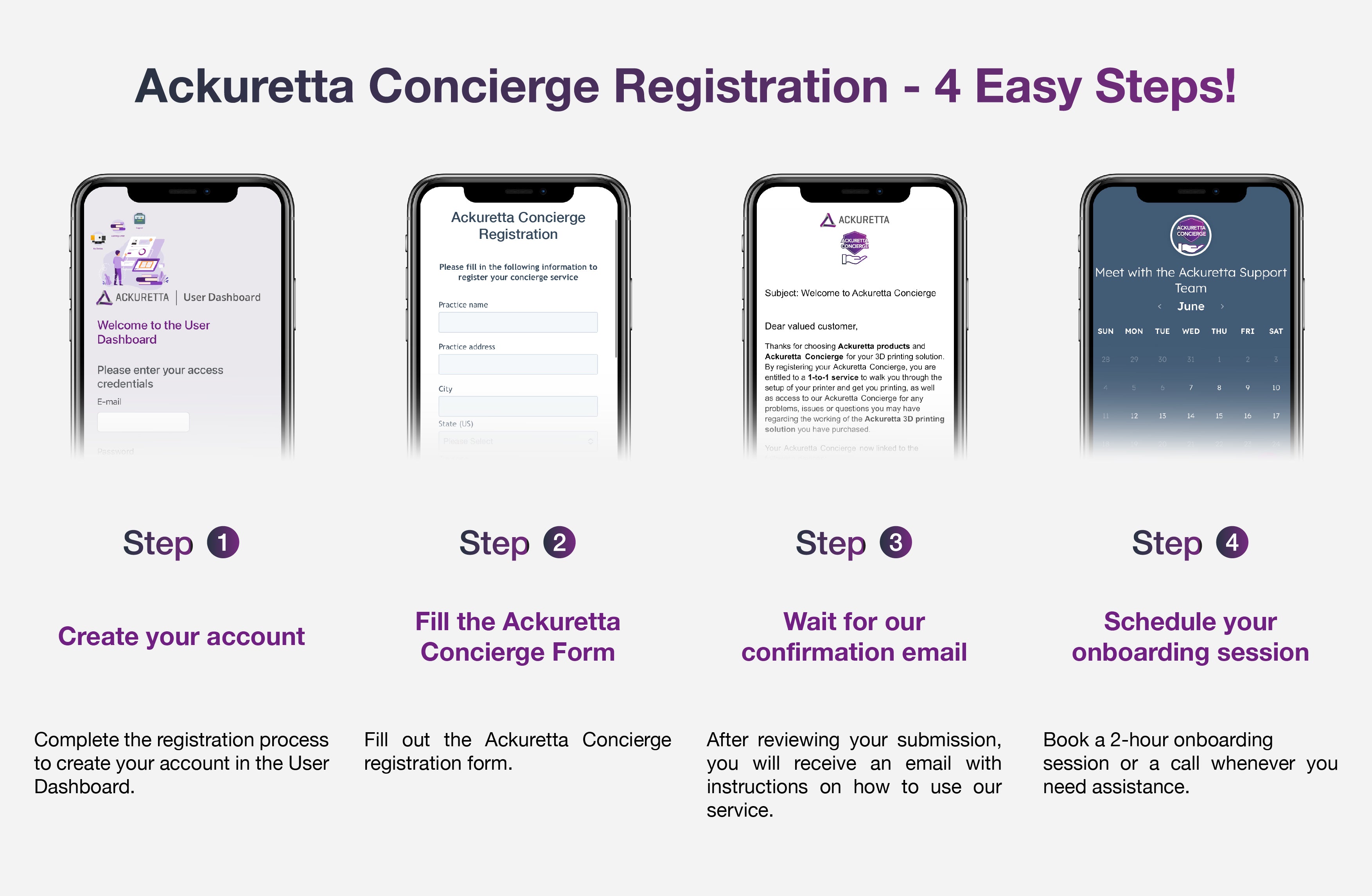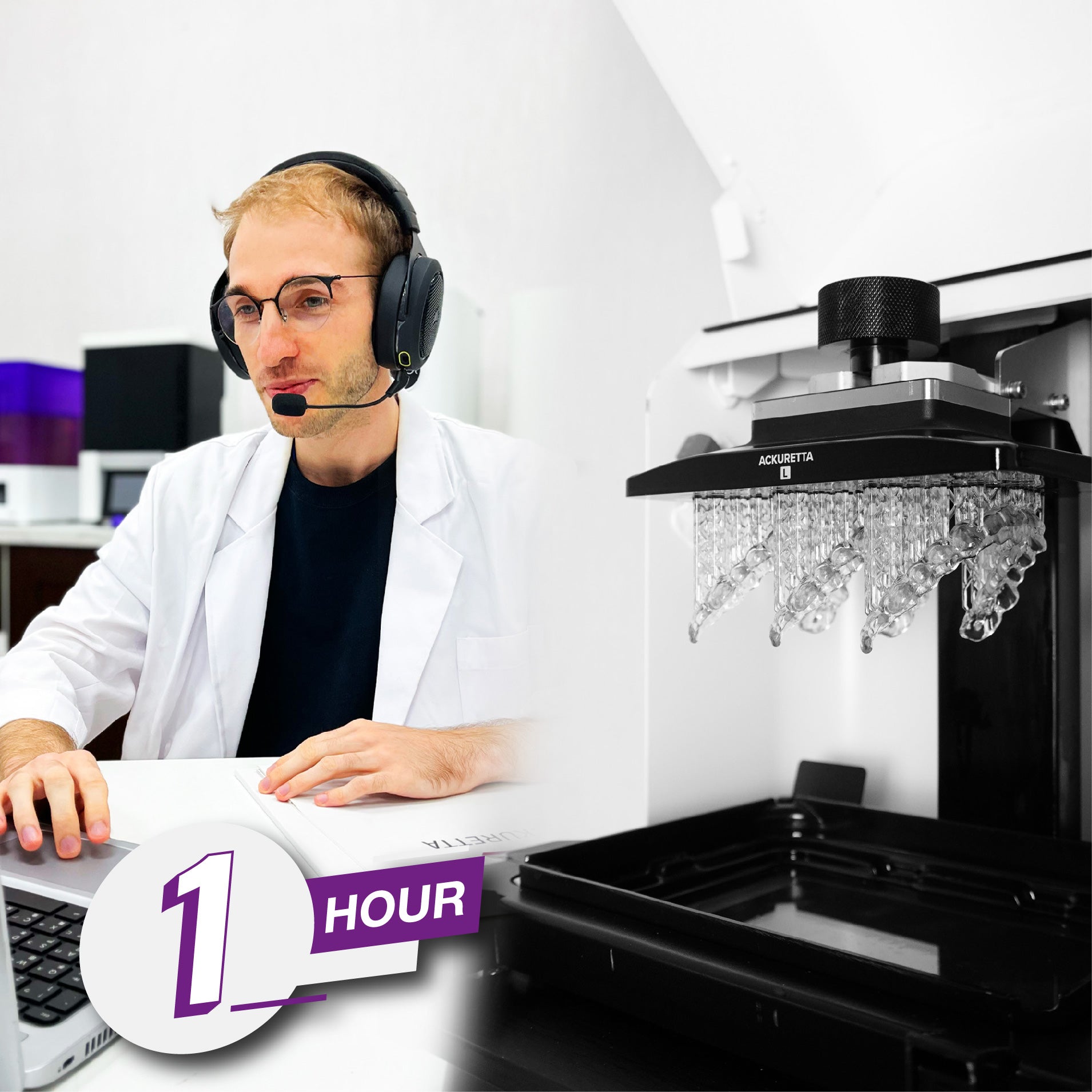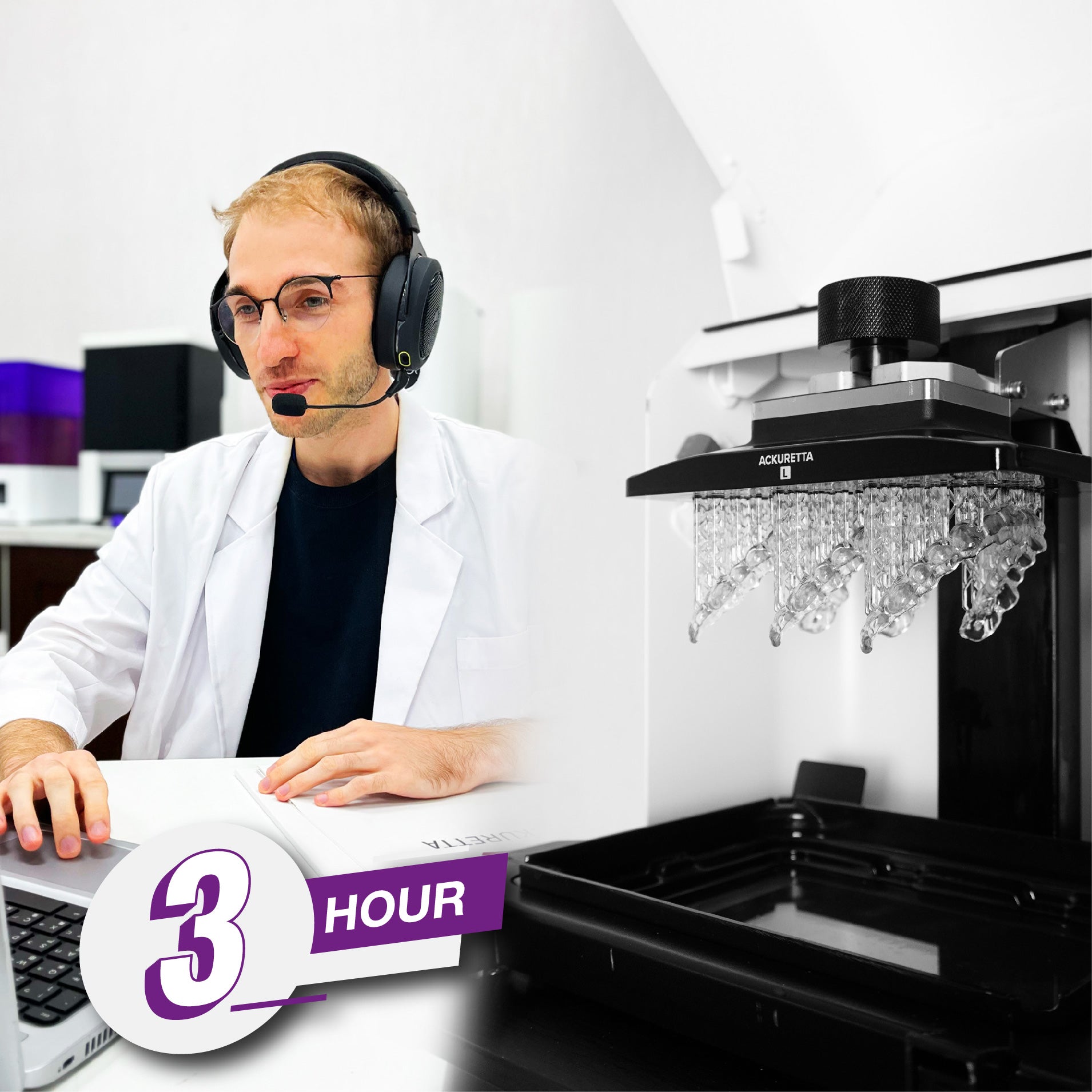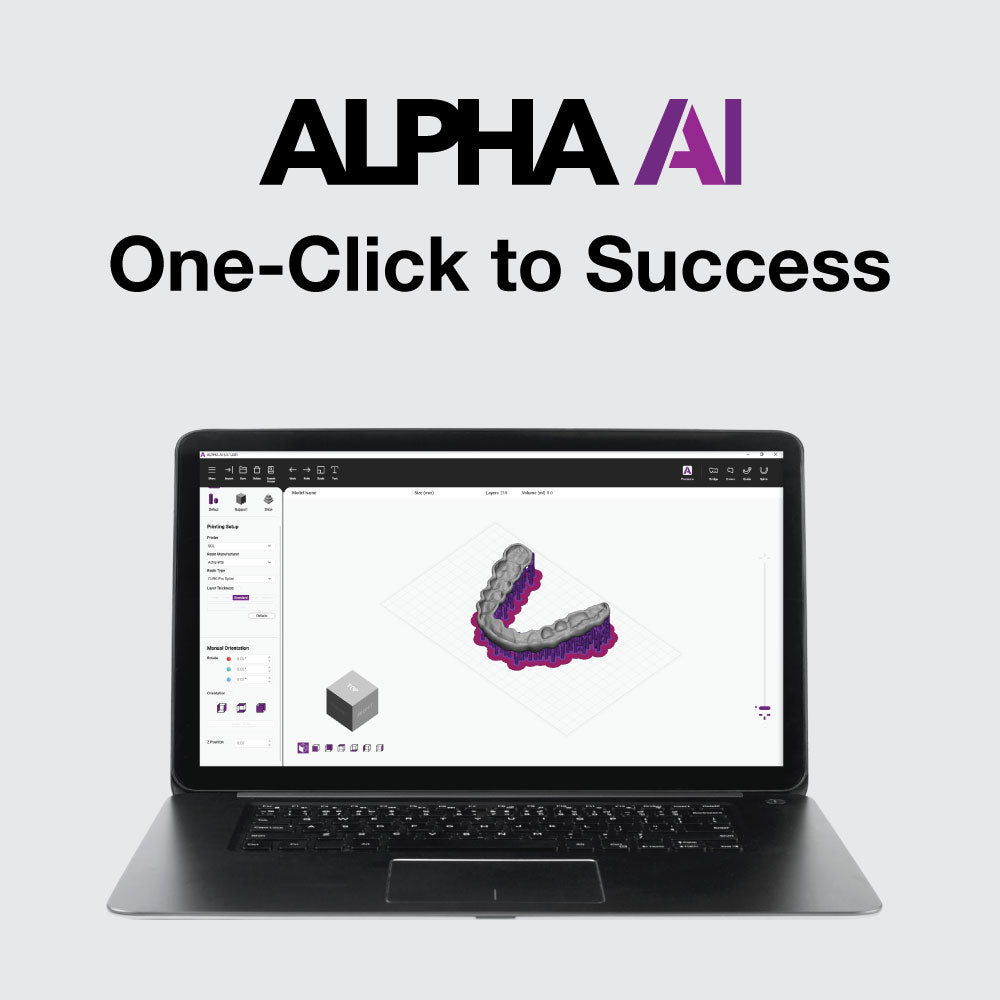Are you just starting your transition to in-house 3D printing and are at a point where you need to find a manufacturer you can trust? -- We’ve all been there.
Type “dental 3D printer” in your search engine - the results will seem overwhelming. Those printers come in all shapes, colors, sizes, and especially prices! On Amazon, you will find astoundingly cheap options from questionable sellers, while distributor websites will promote specialized 3D printers costing up to $ 20,000 USD.
Do you think of 3D printing as learning how to drive a car? You start with a cheap one, so it doesn’t matter if you crash it? -- Well, it’s not the same. Unless you plan on physically throwing your 3D printer.
Unlike cars, quality dental 3D printers have a minimal learning curve and fit into your lab or clinic environment seamlessly. Professional tech support and smartly designed plug & play printers will require no pre-existing tech know-how on your part - you just need to be a dental professional and the rest will be taken care of by the manufacturer.
So let’s talk about pricing - why are some printers so cheap and what do more expensive printers have to offer?
We need to cover 6 key aspects that every buyer of a 3D printer will encounter, these are:
Resolution
Material Calibration
Machine Components
Tech Support
Post-Processing Solutions
Software
Quick Facts:
|
< $1000 Printer |
< $5000 Printer |
< $15,000 Printer |
|
|
Specifications - Resolution |
|
|
|
|
Material Calibration |
|
|
|
|
Tech Support |
|
|
|
|
Machine parts |
|
|
|
|
Post Processing Solutions |
|
|
|
|
Software |
|
|
|
|
Low Price = Low Performance |
Mostly good to excellent price-performance ratio |
Premium price = premium experience |
3D Printer Specifications - Resolution
Inexpensive printers (< $1000 USD) will often seem incredibly impressive in this category, because their resolution is high. But as we’ve discussed in another news article, resolution has little to no bearing on the accuracy of the print. It determines how smooth the surface of the print is.
Now you could say: surface smoothness is very important for dental applications!
Yes, but so is the accuracy of your print. You will have gained little, if your printing result is super smooth, but it deviates dramatically from your original design.
Printers between $2000 USD and $15,000 USD do not just come with high resolution, but also allow for accurate and reliable printing producing repeatable consistent outcomes.
For example, Ackuretta's DENTIQ has a resolution of 47 μm resulting in super smooth 3D printing results.
Material Calibration
If you think that your tech know-how is limited and you aren’t willing to dive in deep, then this category will convince you immediately to go for a more expensive 3D printer.
Inexpensive printers tend to come without ANY material calibration. That means you would need to spend your time doing trial and error prints. Sure, you will develop incredible 3D printing skills, but it will take A LOT OF YOUR TIME and probably nerves.
So as a dental professional that runs a business opt for all-around solutions that do not require you to go through this ordeal. In the end, your patients will thank you because no one wants a dentist or dental tech that’s super stressed out from tech problems.
Manufacturers of specialized 3D printers know the needs of their customers and want to meet those. Thus, their engineers spend their time and nerves on calibrating materials. In the end, you will receive a customized plug-and-play experience - minimizing your manual labor and taking some pressure off your dental techs.
Machine Parts
Are you wondering how a 3D printer can be as cheap as $150 USD? Yeah, we were too. So we tried to take one apart. And well, now we really know why they are so cheap.
They mostly consist of cheap plastics and low-quality components. Once you break one part, it is unlikely that you will be able to fix it yourself. So you toss your 3D printer out and buy another one. In the long run, an inexpensive 3D printer will cost you a lot of time and money.
We strongly advise dental professionals to invest a bit more in 3D printing systems to avoid annoyance and production delays. Because with an increase in price comes an increase in quality. Printers costing less than $5,000 USD tend to have a lifetime of 3-5 years and even more expensive products will serve you well for around 5 to 7 years.
So it’s up to you what you’re willing to pay.
Tech Support
Let’s not beat around the bush - very few of us dental professionals are tech gods. Sometimes that error message just keeps flashing and you’re on the verge of tears because you followed all the steps but it JUST DOESN’T STOP BEEPING!
Nah, we have better things to do with our time than trying to solve every issue that one of the many machines might throw at us on any given day. That’s why there needs to be tech support and ideally, a long warranty period.
Guess what - inexpensive 3D printers mostly come with neither long warranty periods or (capable) tech support. They need to save money in some areas and labor is expensive.
Depending on the manufacturer and the cost of the 3D printer, you will find that they do provide tech support - which puts them ahead of the cheap competition.
In contrast to manufacturers of inexpensive 3D printers, more expensive brands will also have reliable and multilingual customer support. This will make your life considerably easier and can solve most 3D printing issues within minutes.
Our tip is to read user experiences online and you will find that if there are no complaints about the lack of customer support, that this is most likely going to be a fairly good brand to go with.
If you are interested in learning more about Ackuretta’s user group, check it out on Facebook.
Post-Processing Solutions
Dental 3D printing is a complex field, due to the various factors that ensure the safety of the patients. Post-processing is one of these factors because uncured resins are hazardous to the health of humans and the environment - so make sure that what you put in your patients’ mouth is in compliance with strict medical standards.
Inexpensive machines were never designed with dental users in mind. They were created for the DIY market, however, ended up in dental practices and labs. This is also reflected in the post-processing solutions they offer. Post-processing includes the cleaning and curing of the finished 3D print. If you go with non-specialized equipment, you cannot ensure the quality and safety of your finished product.
Instead, purchase from manufacturers that advertise validated workflows - this way you know that biocompatibility is guaranteed and your patients are happy and healthy. Premium manufacturers almost certainly give you this certainty, with slightly cheaper options, you should read their websites and product descriptions thoroughly.
Software
Let’s face it: you won’t be spending much time with your 3D printer, you will be spending a lot of time in front of your computer designing and setting up your design for printing.
Here’s the reality of inexpensive 3D printers: they’re not designed for dental application and their software reflects that. You might be able to do many things with those types of software, but again, you must have the willingness and endurance to teach yourself - if that sounds like fun, then go for it!
But for us regular people, we like easy solutions and software that lightens our workload - not add to it. So invest in a 3D printing ecosystem from start to finish. This way you don’t just make your patients smile, but you might get a smile out of it yourself.
Conclusion
We understand the reluctance of spending tens of thousands on a technology that you are unsure on how to operate. It’s scary. It might cause the initial impulse to get started with a cheaper 3D printing system. But this will inevitably lead to you either 1) abandoning 3D printing altogether because of the added workload or 2) purchasing a more expensive set later on as you value high-quality 3D printers and their additional service more.
If you want to learn more about digital dentistry and want to benefit from the experience of other users, seasoned professionals, or newbies, then join some of the Facebook groups. Dental professionals share their stories all about printing, the materials, finishing kits there - what has worked for them and what hasn’t.
You can also find an Ackuretta User Group on Facebook as well as lots of information on all our products on YouTube or our Website.































































 Loading ...
Loading ...





